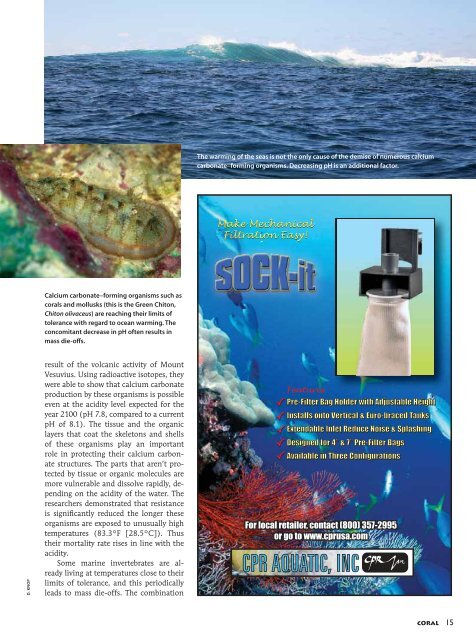Create successful ePaper yourself
Turn your PDF publications into a flip-book with our unique Google optimized e-Paper software.
The warming of the seas is not the only cause of the demise of numerous calcium<br />
carbonate–forming organisms. Decreasing pH is an additional factor.<br />
Calcium carbonate–forming organisms such as<br />
corals and mollusks (this is the Green Chiton,<br />
Chiton olivaceus) are reaching their limits of<br />
tolerance with regard to ocean warming. The<br />
concomitant decrease in pH often results in<br />
mass die-offs.<br />
D. KNOP<br />
result of the volcanic activity of Mount<br />
Vesuvius. Using radioactive isotopes, they<br />
were able to show that calcium carbonate<br />
production by these organisms is possible<br />
even at the acidity level expected for the<br />
year 2100 (pH 7.8, compared to a current<br />
pH of 8.1). The tissue and the organic<br />
layers that coat the skeletons and shells<br />
of these organisms play an important<br />
role in protecting their calcium carbonate<br />
structures. The parts that aren’t protected<br />
by tissue or organic molecules are<br />
more vulnerable and dissolve rapidly, depending<br />
on the acidity of the water. The<br />
researchers demonstrated that resistance<br />
is significantly reduced the longer these<br />
organisms are exposed to unusually high<br />
temperatures (83.3°F [28.5°C]). Thus<br />
their mortality rate rises in line with the<br />
acidity.<br />
Some marine invertebrates are already<br />
living at temperatures close to their<br />
limits of tolerance, and this periodically<br />
leads to mass die-offs. The combination<br />
For local retailer, contact (800) 357-2995<br />
or go to www.cprusa.com<br />
CORAL<br />
15

















